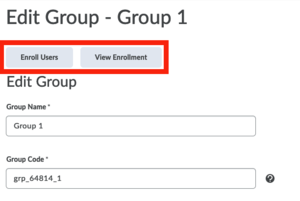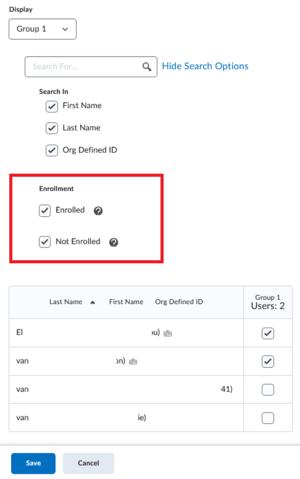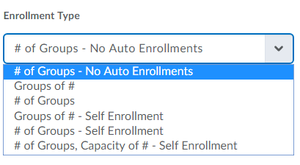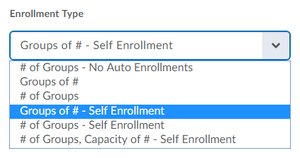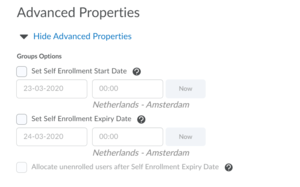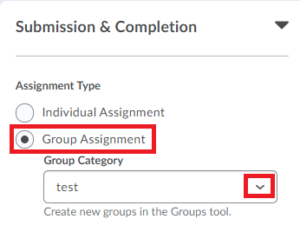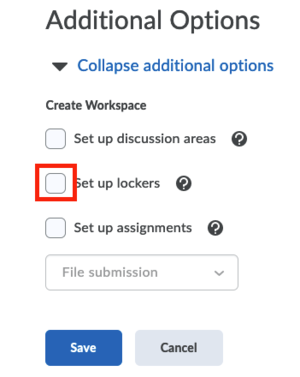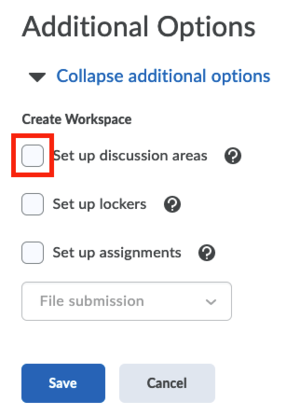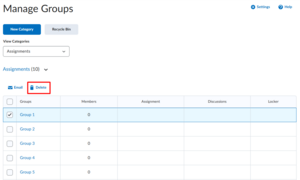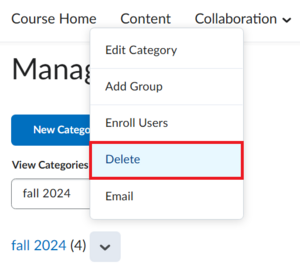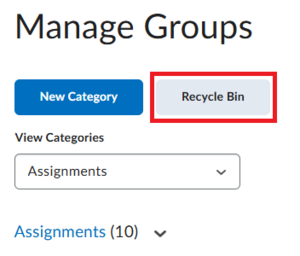Group tool: Brightspace
Each group in Brightspace at the moment has a maximum capacity of two hundred participants and is restricted to two hundred groups per category.
The Brightspace Group Tool enables you to divide the entire class into groups or to group only some of the students. You can group students for administrative purposes or to have them work on assignments together. You can group students manually, automatically divide them into groups or allow them to self-enrol.
If you want to have self-enrolment groups with different sizes or if you want to have a waitlist, you can use the Group Self Enrollment tool.
Create groups
-
- Go to Collaboration in the navigation bar and select Groups.
- Create a New Category, give it a Name and optionally fill in a Description.
- Choose the Enrollment Type. The following options are available: groups with manual enrolment and groups with self enrolment.
Once the groups are published, the descriptions will no longer be visible to students. To make sure that students can still see the description, check the box Make category and group descriptions visible to group members while creating the category.
- Optionally define Advanced Properties. These differ per enrolment type. You can find more information in the accordions about Groups with manual enrolment and Groups with self enrolment below.
- Complete the fields provided.
Group Prefix can be filled in when you want to give the groups a name, for example ‘Workshop’. Brightspace will then create groups called ‘Workshop 1’, ‘Workshop 2’, and ‘Workshop 3’. You can change these names to be something more specific, for example, ‘Monday Workshop’, or ‘Solar Energy Workshop’.
- Decide if you want to make Lockers, Discussion areas and Assignment submission folders available. This depends on the purpose of the groups.
- Click Save.
-
It is possible to create one or more subgroups within a specific group. Imagine an instructor needs to create five subgroups, each with a maximum capacity of two students, within the Workshop Group 1.
- Start by creating a new group category as described above.
- Provide a Category Name, for instance 'Workshop Group 1 Subgroups'.
- After defining the Enrollment Type, Number of Groups and capacity, as described above, it is important to restrict enrolment to the members of Workshop Group 1. This way, only the students that are enrolled in Workshop Group 1 will be able to find and enrol in the groups belonging to 'Workshop Group 1 Subgroups'. You can only apply one enrolment restriction. And once the group is selected, the title of the selected group will automatically be added to the Group Prefix field.
- Save and close.
Subgroups appear in the group list (both for students and instructors) not directly under the groups they relate to, but as a separate group, as any other group. Therefore, it is important to give it a title that clearly shows the relation between main groups and subgroups.
-
Once the groups are created you can modify their Names and add Descriptions. Next, you can enrol students in the Groups as described below. If you wish to move a student from one group to another, you can easily do this by following the instructions in step four.
- Go to Collaboration in the navigation bar and select Groups.
- Click the Group Name to find the options View Enrollment and Enroll Users.
- Go to Enroll Users. Here you will find the option to filter the list of students according to those who are currently enrolled or not enrolled in a group. You can also come back to this field later to change the group members.
- Go back to Groups, click the drop-down menu next to the chosen group category and select Enroll users. This will open a new page with all group Enrollments, where you can easily move students from one group to another.
If you create large groups, the list of group members can be very long and may not show the entire class on one page. Simply click to go to the next page, for example, 2/3, 3/3 etc.
Enrolment types
-
The Enrollment Type drop-down menu lists the existing types of group membership. The first listed option, # of Groups – No Auto Enrollments, is the one where you as the instructor or teaching assistant manually assign students to the groups.
Once the groups are published, the descriptions will no longer be visible to students. To make sure that students can still see the description, check the box Make category and group descriptions visible to group members while creating the category.
-
The Enrollment Type drop-down menu lists the existing types of group membership. The second and third option, Groups of # and # of Groups are the ones where students are automatically and randomly allocated by Brightspace.
-
The Enrollment Type dropdown menu lists the existing types of group membership. The last three listed options, with Self Enrollment, are the ones where students can choose to enrol themselves in a group.
- If you select any of these options, students also have the ability to un-enrol from the group and re-enrol themselves in another. There is a start date and cut-off date and time by which they need to do so. You can also set an expiry date until which students can choose to self-enrol.
- When you create a group with self-enrolment, you can set the start date and deadline for students to decide which group they want to be in within the Advanced Properties. You can let the system enrol the remaining students once the deadline has been reached.
The capacity of self-enrolment groups can be changed after they are created, and prior to the group sign-up expiry date. Decreasing a group size to an amount smaller than has already signed up for a group will not re-allocate users to other groups.
Create Assignments for groups
-
To create an assignment to which an entire group of students can submit, take the following steps:
- Create the assignment. For help with setting up assignments, click here. For this type of assignment, the following information is specifically important:
- In the tab Submission & Completion Settings, select Group Assignment.
- Select the Group Category that you want the assignment to be attached to.
- In the same tab, we recommend that you select the option Only the most recent submission is kept. This will prevent you from receiving emails from students asking if they can resubmit when they find a mistake. If you opt to keep all submissions, you have to pay close attention to assure you are only grading the most recent one.
- Click Save & Close.
- If you would like to create more submission folders for the same groups, you can start at step two again.
- Create the assignment. For help with setting up assignments, click here. For this type of assignment, the following information is specifically important:
Share files in a group
-
- Go to Collaboration in the navigation bar and select Groups .
- Click on the drop-down next to the group category name, and then click on Edit Category.
- Scroll to the bottom of the page. There you see Setup Lockers.
- Select the checkbox and then click on Save.
If you are setting groups from the very beginning, this option is available as part of the set up procedure.
-
Once you have set up the lockers, you can access them.
- Click on Groups, and then go to the category you wish to view.
- In the list of all the groups you can access all their lockers individually, by clicking on the link within the Locker column.
For students, this page looks, but they will only see their own group. Instructors see all the groups.
Group Communication
-
- Go to Collaboration in the navigation bar and select Groups.
- Find the group category and the group you wish to email.
- Check the box next to the group’s name and click on the Email icon.
- A new window will open where you can compose your email.
By using this option, the contacts will appear by default on the bcc: field. The reason for this is to protect the identity of the recipients.
-
Group lockers can be set up within groups to share files with students of a specific group, to allow the students to upload and share files with each other and can be used to email a group directly. More information on creating lockers can be found here.
Once files are deleted from Lockers, they cannot be recovered. This applies to both students and instructors. To avoid accidental deletion, it is recommended to add a text README file, with a note about this. Make sure to add a message to the description of your file with a warning for this, so that students and instructors can see it as soon as they open the locker.
The locker function can also be used by both instructors and students, to email the group members. To do so:
- Go to Groups and click on Group Files to select the group for which you have previously set up lockers.
- On the next page, click Email group members and then follow the same procedure as mentioned above.
-
Another option to communicate within groups is by using discussion forums. Both students within the group and instructors can contribute to the discussion.
To set up discussion areas for a group, follow these steps:- Go to Collaboration in the navigation bar and select Groups.
- Click on the dropdown next to the group category name, and then click on Edit Category.
- Scroll to the bottom of the page and enable Set up discussion areas under Additional Options.
- Select the Forum you would like to associate with the group category. Alternatively, you can create a new Forum.
- There are two options now:
- Create new topic: This will create a separate topic per group. Groups can only see their own discussion
- Attach to existing topic: This will create a new thread for each group in a pre-existing topic. Students will now be able to see the other threads. This option is only available for empty topics without previous group restrictions or posts.
For more information about setting up discussion areas, click here.
Delete groups
Deleting groups has a severe impact. Please consider the following consequences before deleting groups:
-
- When you delete groups, be warned that this will also delete any group assignment submission folders and group discussion topics. The implications are that if a group of students has already uploaded work in a submission folder, that uploaded work will also be deleted. Similarly, any discussion forum that you have set up for groups will be removed.
- When the course is complete and all the grades are submitted, then you might want to consider deleting the groups that were not used. Even then, please take note that you may need to keep some student work as evidence for accreditation or audits in the future. Please do not remove these groups unless you are absolutely certain you have a copy of the work.
-
We recommend this strategy to avoid deleting groups: Simply rename the groups to something beginning with an underscore or a “z”, so that when they are sorted, they appear at the very top or the very bottom and you can ignore them.
-
If you no longer need the groups that were created, you can delete those by following these steps:
- Go to Collaboration and then to Groups.
- Choose the Category from the drop-down. Then select the group(s), you wish to delete by using the checkboxes.
- Click Delete to erase the group(s). The prompt will show you how many assignments and discussions will be deleted as well.
- Click Delete Groups to confirm.
If you want to delete the category as well:
- Click the downward arrow behind the category name.
- Choose Delete.
- Click Delete Category to confirm.
-
If you want to restore a group that you deleted, you can use the Recycle Bin tool. When you restore groups, existing enrolments and lockers are also reinstated (if present). Any activities linked to the restored groups, such as discussions or assignments, can then be individually restored through their respective restore pages.
- Click on Collaboration, then Groups.
- Click the Recycle Bin button.
- Select the groups you want to recover, and click Restore.
Groups and categories, deleted before this feature was introduced in November 2024, do not appear in the Groups Recycle Bin.

